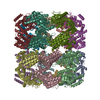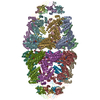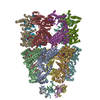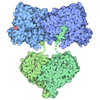[English] 日本語
 Yorodumi
Yorodumi- PDB-8wuw: Cryo-EM structure of H. thermophilus GroEL-GroES2 asymmetric foot... -
+ Open data
Open data
- Basic information
Basic information
| Entry | Database: PDB / ID: 8wuw | |||||||||
|---|---|---|---|---|---|---|---|---|---|---|
| Title | Cryo-EM structure of H. thermophilus GroEL-GroES2 asymmetric football complex | |||||||||
 Components Components |
| |||||||||
 Keywords Keywords |  CHAPERONE / CHAPERONE /  Chaperonin / Chaperonin /  ATPase / ATPase /  protein folding protein folding | |||||||||
| Function / homology |  Function and homology information Function and homology information chaperonin ATPase / protein folding chaperone / chaperonin ATPase / protein folding chaperone /  isomerase activity / ATP-dependent protein folding chaperone / unfolded protein binding / protein refolding / isomerase activity / ATP-dependent protein folding chaperone / unfolded protein binding / protein refolding /  ATP binding / ATP binding /  cytoplasm cytoplasmSimilarity search - Function | |||||||||
| Biological species |    Hydrogenobacter thermophilus TK-6 (bacteria) Hydrogenobacter thermophilus TK-6 (bacteria) | |||||||||
| Method |  ELECTRON MICROSCOPY / ELECTRON MICROSCOPY /  single particle reconstruction / single particle reconstruction /  cryo EM / Resolution: 2.6 Å cryo EM / Resolution: 2.6 Å | |||||||||
 Authors Authors | Liao, Z. / Gopalasingam, C.C. / Kameya, M. / Gerle, C. / Shigematsu, H. / Ishii, M. / Arakawa, T. / Fushinobu, S. | |||||||||
| Funding support |  Japan, 2items Japan, 2items
| |||||||||
 Citation Citation |  Journal: Structure / Year: 2024 Journal: Structure / Year: 2024Title: Structural insights into thermophilic chaperonin complexes. Authors: Zengwei Liao / Chai C Gopalasingam / Masafumi Kameya / Christoph Gerle / Hideki Shigematsu / Masaharu Ishii / Takatoshi Arakawa / Shinya Fushinobu /  Abstract: Group I chaperonins are dual heptamer protein complexes that play significant roles in protein homeostasis. The structure and function of the Escherichia coli chaperonin are well characterized. ...Group I chaperonins are dual heptamer protein complexes that play significant roles in protein homeostasis. The structure and function of the Escherichia coli chaperonin are well characterized. However, the dynamic properties of chaperonins, such as large ATPase-dependent conformational changes by binding of lid-like co-chaperonin GroES, have made structural analyses challenging, and our understanding of these changes during the turnover of chaperonin complex formation is limited. In this study, we used single-particle cryogenic electron microscopy to investigate the structures of GroES-bound chaperonin complexes from the thermophilic hydrogen-oxidizing bacteria Hydrogenophilus thermoluteolus and Hydrogenobacter thermophilus in the presence of ATP and AMP-PNP. We captured the structure of an intermediate state chaperonin complex, designated as an asymmetric football-shaped complex, and performed analyses to decipher the dynamic structural variations. Our structural analyses of inter- and intra-subunit communications revealed a unique mechanism of complex formation through the binding of a second GroES to a bullet-shaped complex. | |||||||||
| History |
|
- Structure visualization
Structure visualization
| Structure viewer | Molecule:  Molmil Molmil Jmol/JSmol Jmol/JSmol |
|---|
- Downloads & links
Downloads & links
- Download
Download
| PDBx/mmCIF format |  8wuw.cif.gz 8wuw.cif.gz | 1.5 MB | Display |  PDBx/mmCIF format PDBx/mmCIF format |
|---|---|---|---|---|
| PDB format |  pdb8wuw.ent.gz pdb8wuw.ent.gz | 1.3 MB | Display |  PDB format PDB format |
| PDBx/mmJSON format |  8wuw.json.gz 8wuw.json.gz | Tree view |  PDBx/mmJSON format PDBx/mmJSON format | |
| Others |  Other downloads Other downloads |
-Validation report
| Arichive directory |  https://data.pdbj.org/pub/pdb/validation_reports/wu/8wuw https://data.pdbj.org/pub/pdb/validation_reports/wu/8wuw ftp://data.pdbj.org/pub/pdb/validation_reports/wu/8wuw ftp://data.pdbj.org/pub/pdb/validation_reports/wu/8wuw | HTTPS FTP |
|---|
-Related structure data
| Related structure data |  37862MC  8wu4C  8wucC  8wuxC C: citing same article ( M: map data used to model this data |
|---|---|
| Similar structure data | Similarity search - Function & homology  F&H Search F&H Search |
- Links
Links
- Assembly
Assembly
| Deposited unit | 
|
|---|---|
| 1 |
|
- Components
Components
| #1: Protein | Mass: 56600.918 Da / Num. of mol.: 14 Source method: isolated from a genetically manipulated source Source: (gene. exp.)    Hydrogenobacter thermophilus TK-6 (bacteria) Hydrogenobacter thermophilus TK-6 (bacteria)Strain: TK-6 / Gene: groL, groEL, HTH_1794 / Production host:   Escherichia coli BL21(DE3) (bacteria) / References: UniProt: D3DK86, Escherichia coli BL21(DE3) (bacteria) / References: UniProt: D3DK86,  chaperonin ATPase chaperonin ATPase#2: Protein | Mass: 10642.385 Da / Num. of mol.: 14 Source method: isolated from a genetically manipulated source Source: (gene. exp.)    Hydrogenobacter thermophilus TK-6 (bacteria) Hydrogenobacter thermophilus TK-6 (bacteria)Strain: TK-6 / Gene: groS, groES, HTH_1793 / Production host:   Escherichia coli BL21(DE3) (bacteria) / References: UniProt: D3DK85 Escherichia coli BL21(DE3) (bacteria) / References: UniProt: D3DK85#3: Chemical | ChemComp-MG / #4: Chemical | ChemComp-ANP / #5: Chemical | ChemComp-K / Has ligand of interest | Y | |
|---|
-Experimental details
-Experiment
| Experiment | Method:  ELECTRON MICROSCOPY ELECTRON MICROSCOPY |
|---|---|
| EM experiment | Aggregation state: PARTICLE / 3D reconstruction method:  single particle reconstruction single particle reconstruction |
- Sample preparation
Sample preparation
| Component |
| ||||||||||||||||||||||||||||||
|---|---|---|---|---|---|---|---|---|---|---|---|---|---|---|---|---|---|---|---|---|---|---|---|---|---|---|---|---|---|---|---|
| Molecular weight | Experimental value: NO | ||||||||||||||||||||||||||||||
| Source (natural) | Organism:    Hydrogenobacter thermophilus TK-6 (bacteria) Hydrogenobacter thermophilus TK-6 (bacteria) | ||||||||||||||||||||||||||||||
| Source (recombinant) | Organism:   Escherichia coli BL21(DE3) (bacteria) Escherichia coli BL21(DE3) (bacteria) | ||||||||||||||||||||||||||||||
| Buffer solution | pH: 7.4 | ||||||||||||||||||||||||||||||
| Buffer component |
| ||||||||||||||||||||||||||||||
| Specimen | Embedding applied: NO / Shadowing applied: NO / Staining applied : NO / Vitrification applied : NO / Vitrification applied : YES : YESDetails: 2.5 mg/mL GroEL and 0.46 mg/mL GroES was incubated on a heat block at 45C for 10 min. | ||||||||||||||||||||||||||||||
| Specimen support | Details: glow discharged at 7 Pa, 10 mA, 10 sec by a JEOL JEC-3000FC auto fine coater Grid material: COPPER / Grid mesh size: 200 divisions/in. / Grid type: Quantifoil R1.2/1.3 | ||||||||||||||||||||||||||||||
Vitrification | Instrument: FEI VITROBOT MARK IV / Cryogen name: ETHANE / Humidity: 100 % / Chamber temperature: 281 K / Details: blot force 10, blot time 3 s |
- Electron microscopy imaging
Electron microscopy imaging
| Microscopy | Model: JEOL CRYO ARM 300 |
|---|---|
| Electron gun | Electron source : :  FIELD EMISSION GUN / Accelerating voltage: 300 kV / Illumination mode: FLOOD BEAM FIELD EMISSION GUN / Accelerating voltage: 300 kV / Illumination mode: FLOOD BEAM |
| Electron lens | Mode: BRIGHT FIELD Bright-field microscopy / Nominal magnification: 60000 X / Nominal defocus max: 1600 nm / Nominal defocus min: 1200 nm / Cs Bright-field microscopy / Nominal magnification: 60000 X / Nominal defocus max: 1600 nm / Nominal defocus min: 1200 nm / Cs : 2.7 mm / C2 aperture diameter: 50 µm : 2.7 mm / C2 aperture diameter: 50 µm |
| Specimen holder | Cryogen: NITROGEN |
| Image recording | Average exposure time: 2.264 sec. / Electron dose: 49.97 e/Å2 / Film or detector model: GATAN K3 (6k x 4k) / Num. of grids imaged: 1 |
- Processing
Processing
| EM software |
| |||||||||||||||||||||||||||||||||||||||||||||||||||||||
|---|---|---|---|---|---|---|---|---|---|---|---|---|---|---|---|---|---|---|---|---|---|---|---|---|---|---|---|---|---|---|---|---|---|---|---|---|---|---|---|---|---|---|---|---|---|---|---|---|---|---|---|---|---|---|---|---|
CTF correction | Details: patch CTF / Type: PHASE FLIPPING AND AMPLITUDE CORRECTION | |||||||||||||||||||||||||||||||||||||||||||||||||||||||
| Symmetry | Point symmetry : C7 (7 fold cyclic : C7 (7 fold cyclic ) ) | |||||||||||||||||||||||||||||||||||||||||||||||||||||||
3D reconstruction | Resolution: 2.6 Å / Resolution method: FSC 0.143 CUT-OFF / Num. of particles: 20233 / Symmetry type: POINT | |||||||||||||||||||||||||||||||||||||||||||||||||||||||
| Atomic model building | Protocol: RIGID BODY FIT | |||||||||||||||||||||||||||||||||||||||||||||||||||||||
| Atomic model building |
| |||||||||||||||||||||||||||||||||||||||||||||||||||||||
| Refine LS restraints |
|
 Movie
Movie Controller
Controller





 PDBj
PDBj



















